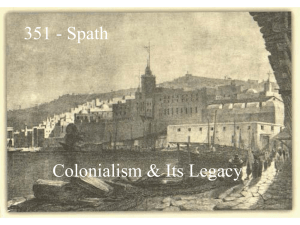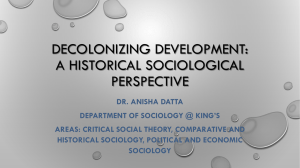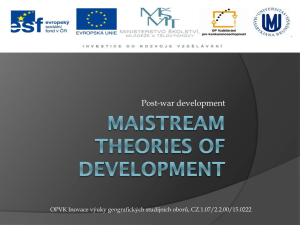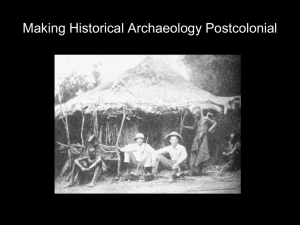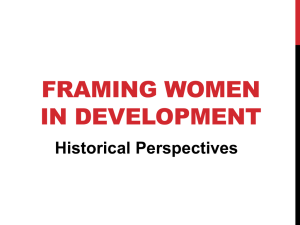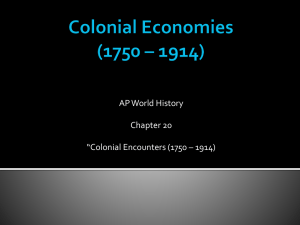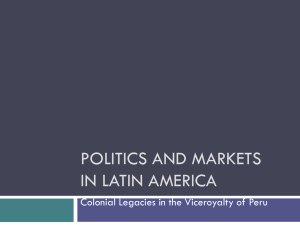Project of colonization, modernity and Modernization school
advertisement
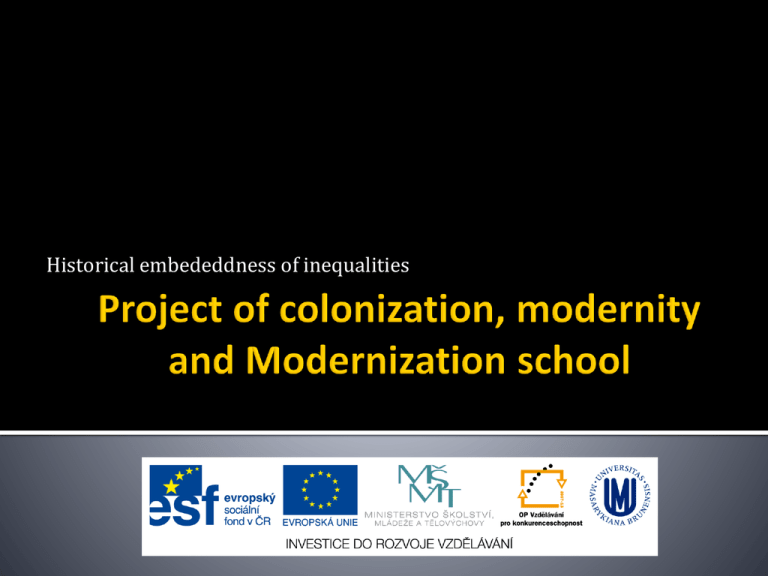
Historical embededdness of inequalities 1) colonialism and its repercussions (impact) on contemporary development 2) modernity as European period and culture 3) main aspects of European project 4) post war development 5) economic theories of development - ´old´ theories of development vs. New theories of growth 6) modernization school - subjugation by physical and psychological force of one culture by another – by a colonizing power – through military conquest of territory . Direct political control and administration of an overseas territory by a foreign state Colonial mission to develop colonial peoples - concept of trusteeshep Cowen, Shenton (1996)- Doctrines of Development Colonialism – institutions and structures of colonialism had profound effect on the colonized societies (Preston) Key factor – relations between local elites and the center power, nationalism – Benedict Anderson Non-European societies were fundamentally transformed by the loss of their resources and craft tradition as their people became colonial subject (labouring in mines, fields, plantations under regime of explorative production Africa - table-drawn boundaries, Scramble for Africa at the Berlin conference (1884–1885), cut across many indigenous communities and created superficial divisions that further aggravated the already complicated situation. A) colonies of settlement – which other eliminated indigenous people (Spanish destruction of the Aztec and Inca civilizations B) colonies of rule – colonial administrators reorganize existing cultures to facilitate their exploitation (British use of local zamindars to rule the Indian subcontintent) Spanish, portugese patterns of colonization – did not bring about economic growth for the colonizing powers; Netherlands and United Kingdom profited British empire – administrators from England – to colonies Incorporation of indigenous people into administrative machinery French – tried to win over the domestic elite, assimilation via education system. Enlightenment interpretation of primitive societies – ideal of innocence Who inspired the approach? MEHMET, O. (1999): Westernizing the Third World, The Eurocentricity of economic development theories, Routledge, London. A great deal of colonial labor was channeled away from reproducing local, non Europen culture and into sustaintin distant European urban and industrial needs. 19th century colonialism became more bureaucratic and centrally organized Late 19th century – colonial administrations in Asia and Africa were self-financing system, Putting to use the loaylty of local princes and chiefs, bought with titles, land and tax-farming privileges. Colonal subjects were forces into cash cropping to pay the taxes that finances the whole colonial enterprise Incorporation of male colonial subjects into cash cropping Disruption of formely comlementary gender roles of men and women in traditional cultures Women´s traditional land-user rights were often displaced by new system of private property Increasing pressure on good prodution, normally the responsibiltiy of women Kenya – the former interdependence between men and women in Kikuyu culture was fragmented – peasants´s land confiscated – men migrated to work on European farms, reduction of women´s control over the resources and lowering their status, wealth and authority. Africa - table-drawn boundaries, Scramble for Africa at the Berlin conference (1884–1885), cut across many indigenous communities and created superficial divisions that further aggravated the already complicated situation. Is colonialism relevant? How ? Consider – political, economic, cultural dimension Political – nation states, impact on stratification of society Economic – patterns of trade Cultural – Rahmena Other dimensions? Development as spread of Modernity Hall and Gieben (1) The Reason and its derivative notion of rationality: “the primacy of reason and rationality as ways of organizing knowledge, tempered by experience and experiment” (Hall, Gieben, 2000: 21). . (2) Empiricism represents a fundamental shift from believing into sensing : “the idea that all thought and knowledge about natural and social world is based upon empirical facts, things that all human beings can apprehend through their sense organs” (ibid.). (3) Science as the driving force fuelling the modernization “Scientific knowledge, based upon the experimental method as developed in the scientific revolution of the seventeenth century, was the key to expanding all human knowledge (ibid) Relevence of science – science at the onset of the modernization project was believed to provide us with unequivocal and indisputable knowledge Braidotti et al. (1994) write of Western science as of the motor of the crisis. Braidotti (1994:10) role of science that assumes ´totalizing control over reality´. “Science with its claims to objective truth plays an important role in the way we think and act, in the way the modern societies function” (Braidotti et al, 1994: 9, emphasis added). Vandana Shiva (Post-development Reader, Rahmena, (4) Universalism, “The concept that reason and science could be applied to any and every situation and that their principles were the same in every situation. Science, in particular, produces general laws which govern the entire universe, without exception” (Hall, 2001: 21; emphasis added (5) Progress - idea that the natural and social conditions of human beings could be improved, and would result in an ever-increasing level of happiness and well-being” (Hall, 2000: 21). The founding concepts of social science - intimately bound up with the Enlightenment’s concept of science that offers the possibilities of control. During much of the development era t- he concept of progress was narrowly viewed as economic growth, which in turn was summarized by the growth of the GDP. Cf measurements of uneven development progress understood as economic growth is either ancient or universal Deboraj Ray in her Development economics (2007) economic growth is the modern invention and there is nothing universal or necessary about it. “Economic growth (cf Kuznets 1996) is a relatively modern phenomenon. Throughout most of human history, appreciable growth in per capita gross domestic product (GDP) was the exception rather than rule. In fact it is not far from the truth to say that modern economic growth was born after the Industrial Revolution in Britain” (Ray, 2007: 48; emphasis added). Rostow identifies: “The value system of these societies was generally geared to what might be called a longrun fatalism” (Rostow, 1962: 5). Which entailed also undesirable ascriptive allocation of status within the traditional societies: “Generally speaking, these societies (…) had to devote a very high proportion of their resources to agriculture; and flowing from the agricultural system there was a hierarchical social structure, with relatively narrow scope – but some scope of vertical mobility” (Rostow, 1962: 5). as Hall explains further: “The founding concepts of social science were intimately bound up with the Enlightenment’s concept of progress, the idea that through the application of reasoned and empirically based knowledge, social institutions could be created that would make men happier and free from cruelty, injustice and despotism” (Hall, 2000: 37). The concept of progress is intrinsically connected with science as science offers the possibilities of control. (6) Individualism is the concept that the “individual is the starting point for all knowledge and action, and that individual reason cannot be subjected to a higher authority” (Hall, 2000: 22; emphasis added). Out of this characteristic stems the methodological individualism that prevailed in economics throughout the 20th century (7) Toleration is the notion that all human beings are essentially the same, despite their religious or moral convictions, and that the beliefs of other races or civilizations are not inherently inferior to those of European Christianity” (Hall, 2001: 21). (8) Freedom can be defined “an opposition to feudal and traditional constraints on beliefs, trade, communication, social interaction, sexuality, and ownership of property” (ibid.). Uniformity of human nature means “the belief that the principal characteristics of human nature were always and everywhere the same” (Hall, 2000: 22). liberation from tradition and other constraints and the pursuit of individualistic aspiration it is in sharp contrast with the existence of colonialism. Cf . large part of the project of modernity occurred during the colonial times. 10) Secularism Existence of religion-free PUBLIC SPHERE virulent anti-clericalism. The philosopher’s opposition to traditional religious authority stressed the need for secular knowledge free of religious orthodoxies” (Hall, 2000: 22). multiplied the already existing cleavages in the torn societies, but beside the existing tribal, regional and religious cleavages another one was created and imposed upon the former colonial subjects – the national one. the case in Africa, where the table-drawn boundaries, conceived during the Scramble for Africa at the Berlin conference (1884–1885), cut across many indigenous communities and created superficial divisions that further aggravated the already complicated situation. CONDITIONS OF POST-WAR DEVELOPMENT development process = process of capital formation; Capital formation is largely determined by levels of savings and investment Growth = function of savings and investments (S,I) Focus on high-growth sectors such as manufacturing ( to the detriment of agriculture) In instances where market imperfections prevent this process from reaching a successful conclusion, intervention may be required form the state and/ or external sources Marshall – Principles of economics (1890) General equilibrium Self-clearing markets Laisser faire- laisser passer PRINCIPLE OF NON-INTERVENTION (BY STATES) Neoclassical models neglect structural rigidities common to developing countries Prevent market form responding to price changes in ´NORMAL´ E.G. THEORIZED MANNER As income levels increase with development MARGINAL PROPENSITY TO SAVE (MPS) Growth – self-sustained character Growth – market driven; however breaking free form the inertia of long term stagnation might require extensive state intervention. Growth theory – development process of capital formation; Capital formation is largely determined by levels of savings and investment Focus on high-growth sectors such as manufacturing In instances where market imperfactions prevent this process from reaching a successful conslution, intervention may be required form the state and/ or externam sources As income levels increase with development MARGINAL PROPENSITY TO SAVE (MPS) Growth – self-sustained character Growth – market driven; however breaking free form the inertia of long term stagnation might require extensive state intervention. Neoclassical models neglect structural rigidities common to developing countries Prevent market form responding to price changes in ´NORMAL´ E.G. THEORIZED MANNER Growth theory – development process of capital formation; Capital formation is largely determined by levels of savings and investment Focus on high-growth sectors such as manufacturing In instances where market imperfactions prevent this process from reaching a successful conslution, intervention may be required form the state and/ or externam sources As income levels increase with development MARGINAL PROPENSITY TO SAVE (MPS) Growth – self-sustained character Growth – market driven; however breaking free form the inertia of long term stagnation might require extensive state intervention. In search on a mono-causal explanations the divine recipe to induce development The dangerous idea of self-sustained growth – automatic process Cypher, J.M.; Dietz, J.L.: The Process of Economic Development, Routledge, 1997. Growth is regarded as unilinear process Self-sustained once the big-push is introduced Possibilities of decline or underdevelopment are not taken into account Once the snowball starts to move downhill, it will move of its own momentum You have, as it were, to begin by trolling your snowball up the mountain. Once it get there, the rest is easy, but you cannot get it there without the first making and initial effort. The rise of growth theory - rift in mainstream development studies Older orthodox neoclassical theory replaced by Keynesian interventionist school However continued stress on the importance of a ´pure´ market and export-led growth Principle of comparative advantage Neoclassical theory is static and focused on allocation of given resources Development problems – dynamic; focus on increasing investable resources through stimulation of savings and investment Big push needed to initiate the process Neoclassical theory offers only marginal adjustment and piecemeal improvements Neoclassical models neglect structural rigidities common to developing countries Prevent market form responding to price changes in ´NORMAL´ E.G. THEORIZED MANNER The neoclassical emphasis on development – comparative advantage + free trade = inappropriate to the late industrializes of the South Direct static losses from state intervention to support industrialization – more that offset by dynamic gains Dynamic gains = technological change, improved skills, long-term benefits from infant industries Growth theory – structured by Eurocentric vision of development based in Keynesian interpretation of the unique albeit historically important experience of core industrial capitalism ´New nations´ - were to follow the Western model ´Modernization imperative´ Nayar 1972 Based on a stylized version of Western economic history Sequence of states on a unilinear path toward higher Western-style development Rosenstein-Rodan – hidden potential for economic development Taking advantage of increasing returns from large scale planned industrialization Several sector simultaneously Modernization –mixture of development factors – technological change capital accumulation changing values and attitudes Inducing social change (values, norms, beliefs, customs) Theorization of such social change – principally via conceptual apparatus of classical sociology “The term path dependence has been used to describe the important role which historical events and historically formed institutions have in determining the future range of possibilities for a nation. Once institutions have been formed, they tend to lock-in certain evolutionary path for the nation [Fieldhouse, quoted by Cypher, Dietz, 1997:72]



